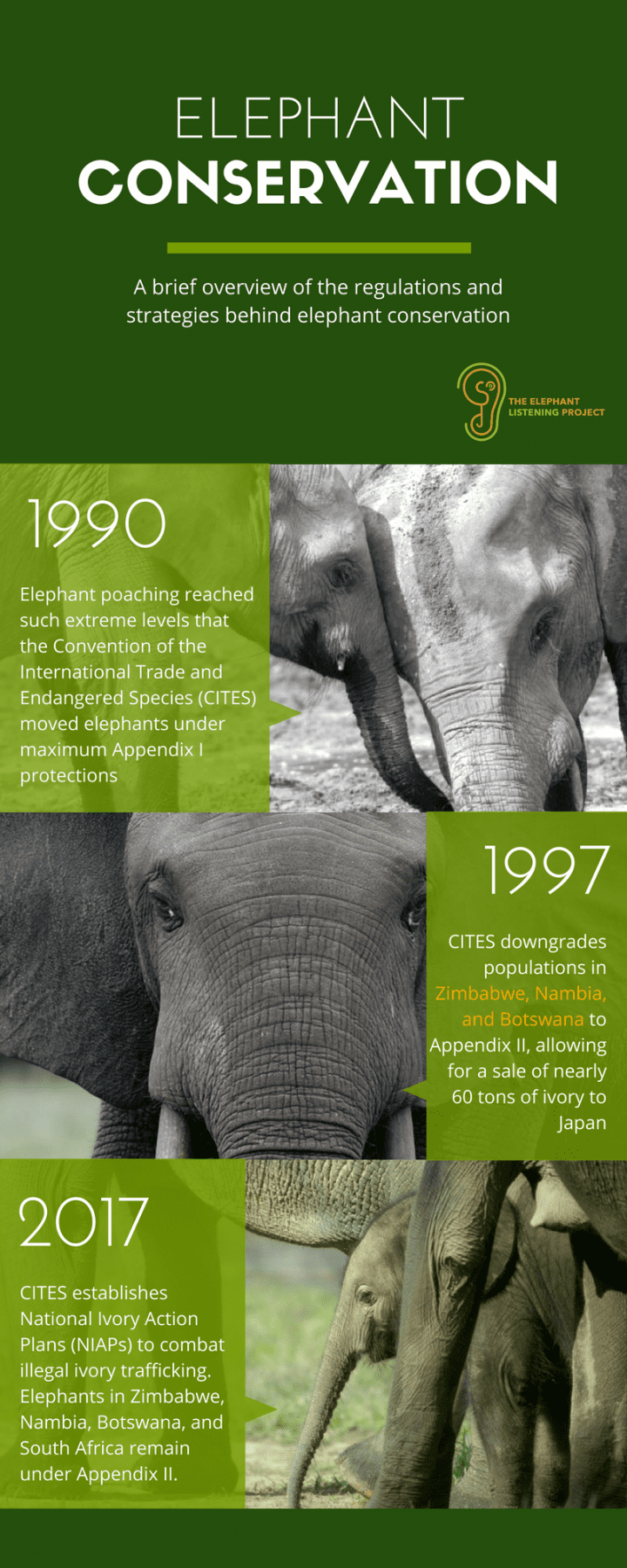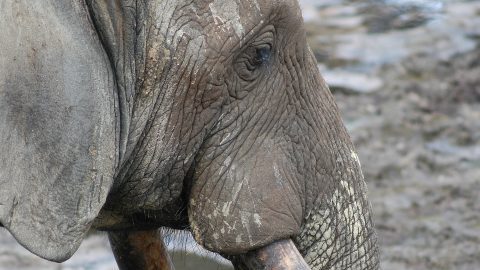Brief History of Conservation
Regulating International Trade

In the 1970s and 1980s, elephant poaching was at a dramatic high. At the time, elephants were listed under Appendix II by CITES (the Convention of International Trade and Endangered Species). Under Appendix II, species are not necessarily threatened by extinction but their trade requires control to avoid use that would interfere with their survival. Elephants were monitored by CITES, but making the distinction between legal ivory and illegal ivory proved very difficult at the time. It was estimated in 1980 that Africa boasted a million elephants, but by the end of the decade the estimate was that only 400,000 remained (1). The drastic decline in population was brought to the attention of CITES and a proposal was brought forth to move the elephants under Appendix I. Species under Appendix I are threatened with extinction and the trade of these species is only permitted in exceptional circumstances.
Not everyone was an advocate for listing elephants under Appendix I. Conservationist around the world and several South African countries argued that the listing was unnecessary in some places. South Africa, Namibia, Zimbabwe, and Botswana claimed that their elephant populations were growing at the time and were putting a strain on the ecosystem and local people. Some countries used the profits from legal harvesting of ivory, meat, and hides to support conservation and management. There was concern that with the new listing, crucial funds would be lost and conservation would suffer.
Nonetheless, in 1990 CITES approved the listing of elephants under Appendix I. The resulting ivory ban caused a drop in the price of ivory and a decline in the number of elephants killed illegally (2). As the years passed, the ivory ban remained a hot debate. There were those who demanded a continuance of the ban out of fear that, without it, an increase in demand would trigger an increase in poaching (3). Those who proposed to uplift the ban cited past arguments — overpopulation in some areas, human-elephant conflict, and the potential for profits.
In 1997, CITES chose to continue listing elephants under Appendix I. However, Zimbabwe, Botswana, and Namibia had successfully proposed to have the elephants in their countries listed under Appendix II. This was to allow for the sale of nearly 60 tons of stockpiled ivory that the three countries had to Japan (4). South Africa’s elephant population was transferred back to Appendix II in 2000. During the years following, poaching increased in Africa, reaching crisis levels in 2011.
Since 2007, little has changed for elephants. CITES includes all elephants under Appendix I except for those in Botswana, Namibia, South Africa, and Zimbabwe. These countries are allowed restricted trade in elephant parts, because their elephant populations are “not necessarily now threatened with extinction.”
The CITES Conference of the Parties in 2017 also established National Ivory Action Plans (NIAPs) in several member states, classifying parties with a level of illegal ivory trafficking concern based on the Monitoring of Illegal Killing of Elephants (MIKE) and the Elephant Trade Information System (ETIS). These NIAPs are aimed at combating the illegal ivory trade, and we can only hope they help produce the intended outcome.
Conservation
 Threats
ThreatsA combination of threats, some unique to forest elephants, threaten their survival.
 Our Solutions
Our SolutionsResearch, anti-poaching strategies, capacity-building, and outreach are the tools we are using to make a difference.
 Building Capacity
Building CapacityBuilding, training, and developing a support infrastructure for a new generation of conservationists
 Outreach
OutreachInforming a bigger circle of people, changing attitudes, making a difference.
References
1. Christo, C (2012). Special for CNN news
2. Dobson, AP and JH Poole (1992). Ivory: Why the ban must stay! Conservation Biology 6: 149-151.
3. Padgett (xxxx). Palaeogenomes of Eurasian straight-tusked elephants challenge the current view of elephant evolution. eLIFE 6:e25413.
4. Bulte & Kooten (1999). Elephant Genetics: Statement on the taxonomy of extant Loxodonta.





